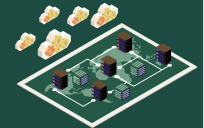![]()
It all starts with six small words. “May we use your current location.” It’s a familiar phrase we are all familiar with when we download nearly any app from the iTunes or Google Play App Stores. This simple request opens a whole new world to data creation that can be applied to everything from market research to targeted coupons. As consumers, we have regularly provided this type of information to corporations. The questions could have taken various forms including a retail clerk asking for your zip code or phone number starting with the area code at checkout. It simply was not always obvious why the clerk was asking for this information.
Corporations were also consuming government data to improve their businesses. For example, census data was used to help develop target markets or choose locations for expansion and new opportunities. The open data movement promised a launch of new consumer facing apps using government data as their foundations. Data from parks and wildlife agencies supported the launch of focused fishing and park finder apps. A perfect example is Fishidy, a waterway-based fishing social network to connect local anglers with the latest fishing reports, catches and spots.
What is now emerging is a new form of a public-private partnership between the creators of consumer apps and governments. This is an interesting reversal of a long standing one way process whereby governments created data and extended it under the banner of transparency or in hopes of stimulating the economy through increased commerce. What’s emerging is a trend where governments provide their data to software developers in exchange for real-time crowdsourced information collected through these consumer apps. All for free!
A perfect example of this new two-way trend is the Waze Connected Citizen Program. Waze is the popular community-based traffic and navigation app whose main purpose is to save drivers time in their day by bypassing poor or congested road conditions. Waze uses government data such as street, construction, weather, major traffic events, and road closure information to populate their app. In exchange for the free use of the app, the public supplements the information by reporting hazards, accidents, and slow traffic. A win for everyone!
Government disciplines including transportation, engineering, public works, law enforcement, public safety, and transit are using a GIS-centric data feed connector and an API to pull Waze data into their geographic information systems (GIS) in real-time. The data provides for an opportunity to analyze and communicate patterns such as traffic impendences, accidents or traffic jams per mile, pot holes, missing signs, and my favorite road kill per mile. Data-driven decisions are enhanced by providing data insights and better traffic management through an operations dashboard. Through a common operational picture, awareness leads governments to rethink infrastructure maintenance, placement of traffic signals, public transportation services, and the way they plan road networks.
The proof that there is a return on investment for this new model speaks for itself. In Boston, use of GIS has shown a reduction of traffic congestion by 18 percent month over month. Rio De Janeiro saw a 27 percent reduction in morning commute time. Travelers on the Pennsylvania turnpike during the pope’s visit helped reduce congestion by 20 percent.
This new public-private partnership is starting to take off in numerous markets including, parks and recreation, healthcare, and public safety. I encourage you to look at the relationship foundational technologies and the start-up community can have to encourage a mutually beneficial exchange of data that results in greater analysis and real-time.
Christopher Thomas is part of the GovLoop Featured Blogger program, where we feature blog posts by government voices from all across the country (and world!). To see more Featured Blogger posts, click here.





Good article. So we FishAngler.com are using many government resources of GIS data and it’s been great! We pulled in millions of Bodies of water (lakes, streams, rivers, ocean, dam), FishSpecies data from NOAA and Water monitoring from NOAA & USGS! We would live to work with various government agencies as our social network of anglers grows!